Task Management: How Do You Keep on Top of Multiple Projects?
In the architecture world, managing multiple projects simultaneously is both a challenge and an art and needs careful task management. With the intricacies of design, coordination, and communication involved, it’s easy to feel overwhelmed. Unanticipated issues often arise, demanding immediate attention and disrupting even the best-laid plans. For many firms, this can lead to a reactive, firefighting approach, rather than proactive progress.
At Pier Architects, we’ve mastered the complexities of project management. Our secret? A structured, technology-driven approach that ensures we stay ahead of the curve. By integrating advanced project and drawing management software, we maintain clarity, streamline communication, and keep every stakeholder on the same page. Let’s dive into how we do it.
The Challenges of Architectural Project Management
Architectural projects involve more than just juggling tasks. They require coordinating a vast network of information, timelines, and people. Without the right tools, managing this complexity can become overwhelming. Traditional methods like lists and manual tracking can offer some structure. However, these approaches often fall short when unexpected issues surface.
In a typical day, urgent client requests, last-minute revisions, and unforeseen coordination errors can throw off a carefully planned schedule. These disruptions often lead to a reactive mindset. Without a solid system, this cycle can persist, turning project management into a constant struggle.


Leveraging Technology for Superior Project Management
At Pier Architects, we believe that technology is the cornerstone of effective project management. That’s why we’ve invested in a powerful project and drawing management software system. This tool isn’t just an add-on; it’s the backbone of our operations. By centralizing tasks, communication, and documentation, it enables us to manage complexity with ease.
- Streamlined Task Management:
Our software breaks down complex projects into manageable tasks. Each task is assigned to a team member with a clear deadline and priority. This structured approach removes ambiguity, ensuring that everyone knows what to do and when to do it. As a result, tasks don’t get lost in the shuffle.
- Enhanced Collaboration:
In our field, collaboration is crucial. Our system creates a central hub where clients, consultants, contractors, and suppliers can communicate. This transparency ensures that all project-related discussions, decisions, and updates are captured in one place. Everyone stays informed, fostering a collaborative environment that drives projects forward.
- Centralized Document and Drawing Management:
Our software also serves as a central repository for all project documents and drawings. This feature is vital in reducing errors. With everyone accessing the latest information, confusion is minimized. Whether it’s a design update, a revised schedule, or a new specification, the current data is always at hand.
- Focused Communication:
We eliminate the need for endless emails and scattered messages. Our platform consolidates all communication, making it easy to track conversations and updates. Automatic notifications ensure that team members stay on top of tasks and deadlines. This organization keeps us focused and productive.
The Impact on Our Practice
The adoption of this system has transformed our practice. We’re more efficient, our work quality has improved, and our projects are delivered on time. Clear processes allow our team to focus on what they do best—designing exceptional spaces that meet our clients’ needs. The reduction in errors, improved collaboration, and ability to manage multiple projects simultaneously have all contributed to our success.
Clients also benefit from this approach. They appreciate the transparency and accessibility of our system. Knowing they have access to the most current information builds trust. As a result, our clients feel engaged and informed throughout the project lifecycle.
Effective project management in architecture demands more than just organization—it requires the right tools. At Pier Architects, our commitment to leveraging technology enables us to stay on top of multiple projects, ensuring precision, collaboration, and successful delivery. Through our advanced systems, we can focus on creating exceptional designs, building strong client relationships, and maintaining our reputation for excellence.




